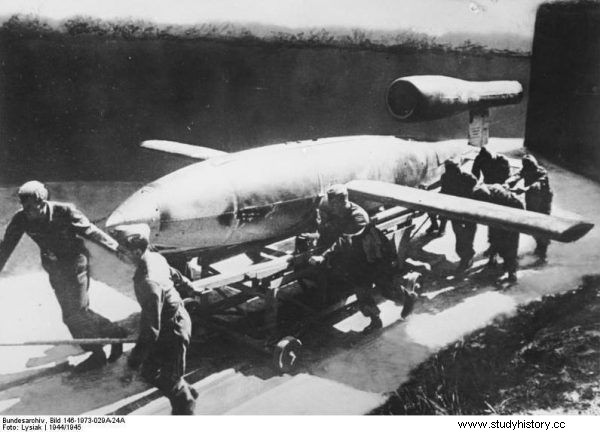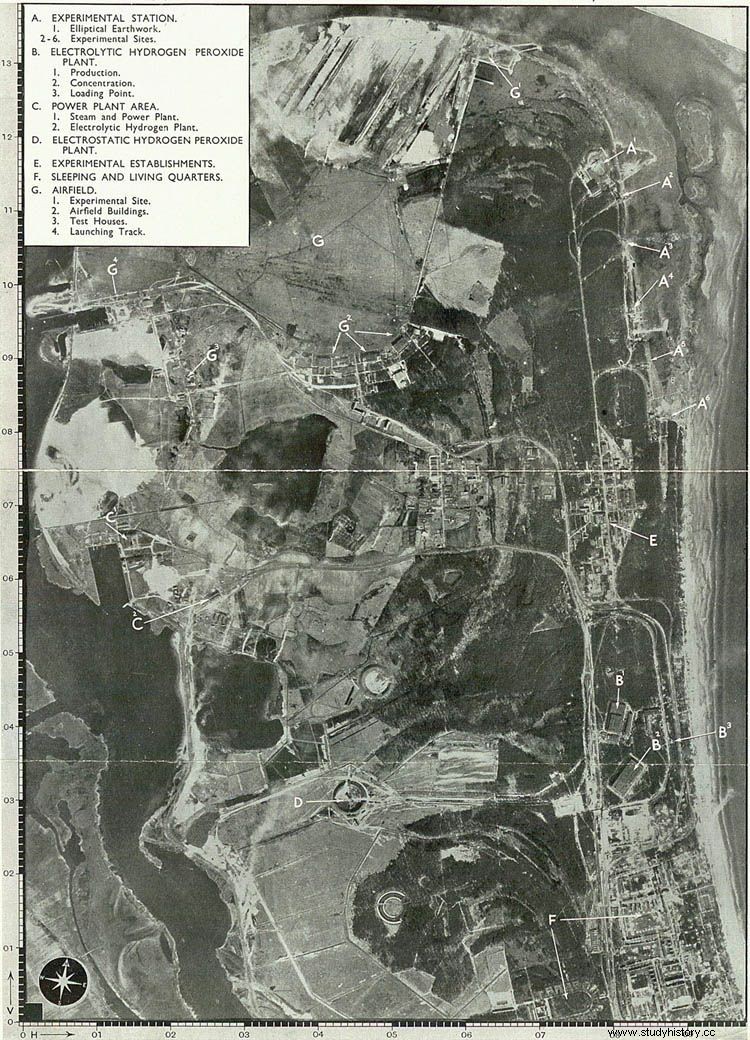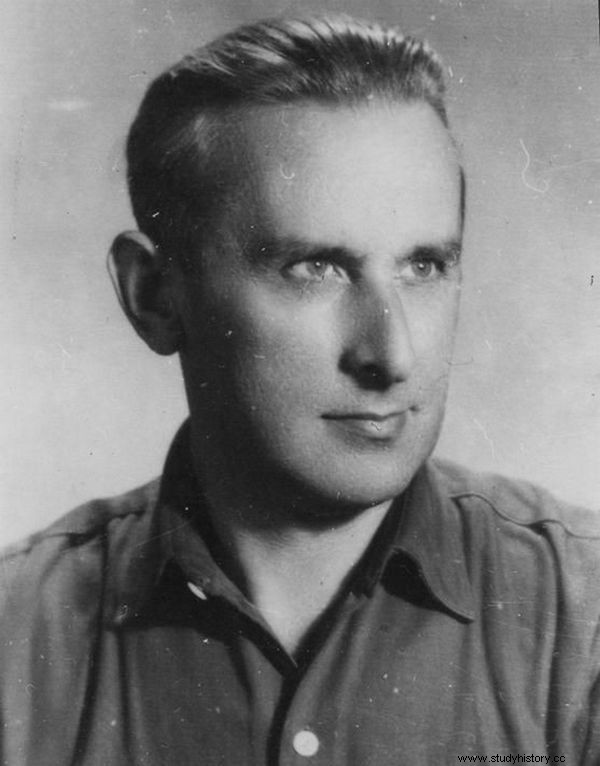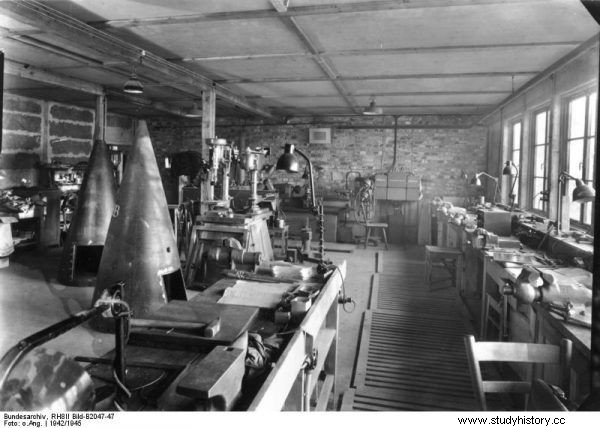Did the Home Army, struggling with supply problems and armament shortages, have any chance in the fight against Hitler's "miracle weapon"? The action in Peenemünde shows that it not only had but also was successful. How did she do it?
One of the greatest achievements of the Home Army's intelligence service is the development of German testing grounds on the island of Usedom (Usedom).
Thanks to reports delivered to London in the spring and summer of 1943, the Allied air force carried out a massive bombing raid on the Peenemünde infrastructure, which extended the V1 and V2 tests by several months. It should be emphasized that the members of the United Organizations of the Sword and Plow Movement ("Sword and Plow") made a significant contribution to the Home Army's success.
Hitler's "Wunderwaffe" (miracle weapon) was supposed to tip the tide of victory in favor of the Third Reich. Work on the construction of missile systems in Germany began immediately after the end of World War I. In the 1930s, the young scientist Wernher von Braun, who later became the father of the American space program, rose to the main figure in this endeavor.
In 1936, on the island of Usedom in Peenemünde, a testing ground for the command of the Wehrmacht land forces was established, where new missile weapons were tested, culminating in an A4 missile, more commonly known as V2 . A few years later, the island also began work on an unmanned aerial vehicle filled with explosives (a flying bomb), commonly known as the V1. In this case, the project was overseen by the Luftwaffe.

On the island of Usedom, work was also carried out on flying bombs. The photo shows the soldiers preparing the V1 rocket for take-off.
The Home Army is working out the Germans
At the end of 1939, the British received the so-called Oslo report containing information on German trials with new weapons. However, they treated the reports with a grain of salt. Also, subsequent reports and information arriving on the islands did not arouse sufficient interest. Only the reports of the Home Army in the spring of 1943 and the overheard conversation of two German generals taken prisoner in Africa changed their approach to the matter.
The first information about new German weapons was received by the KG ZWZ in July 1941 from the intelligence of the Łódź District Command of the ZWZ. However it was only after a dozen or so months that it turned out that the fuselages of small aircraft produced in Raabe's factory in Łódź were not components of the machines for searching for training torpedoes at sea, and the V1 components . In May or June 1942, the first report on this subject was sent to the Staff of the Commander-in-Chief.
From the beginning of 1943, an agent of the offensive intelligence network of the Home Army Headquarters in the west, codenamed "Lombard", Eng. Jan Szreder "Furman". His task was to investigate the German armaments plants on the coast and to maintain contacts with Poles working there. Intelligence work in this area was also carried out by other underground organizations, including the Secret Military Organization "Gryf Pomorski" and the Movement "Miecz i Pług" (MiP). Reports on German tests with new weapons also came to the Home Army command from intelligence networks operating in other areas.
The real breakthrough came at the beginning of 1943. In a report (2/43) sent to the Staff of the Commander-in-Chief in February, it was reported that tests were carried out in Peenemünde with rocket engines, which were to be used to increase the speed of bombers. The March report, in which we read:
, was more preciseFor further information (sic!) , given in meld. 2/43, news received from February that in Penemünde (sic!) n / The Baltic is the center of the center V1 and V2 on display at the Imperial War Museum in London construction and testing of rocket aircraft. There is a f-ka [factory - W.K.] , in which he supposedly works [circa (approximately) - W.K.] 8,000 people /? /, a laboratory and an experimental airfield. Within a few km. all roads are closed from Penemünde station. Travel only with special passes / to be checked /
Valuable information
At the same time, MiP obtained extremely valuable information. The commander of the organization in this area was Augustyn Träger (Austrian after his father) living in Bydgoszcz. It turned out that his son Juliusz Roman Józef Träger (he used his middle name), who had been incorporated into the Wehrmacht, ended up as a non-commissioned communications officer at the experimental center in Peenemünde.

Aerial photograph of Peenemünde, taken from an RAF plane in April 1943.
During the pass in the second half of April 1943, Roman told his father about the large rocket trials on the island. Although Augustyn was skeptical about his son's findings, he passed the news along with a hand-made sketch of the objects to the representatives of MiP in Warsaw .
In the spring of 1943, Lieutenant Stefan Ignaszak "Nordyk" began his underground work. After training on intelligence courses in Great Britain, he was assigned to "Lombard" as an inspector of intelligence networks, supervising 10 independent networks (groups). In the context of the investigation of "Wunderwaffe", a special role was played by the "Bałtyk" Group established in June 1943, commanded by 2nd Lt / Lt. Bernard Kaczmarek "Wrzosa" aka "Jura".
It consisted of the following subgroups:"Bałtyk 301" by Edmund Czarnowski "Kolski", covering the areas of Tczew, Gdynia, Gdańsk, Elbląg and Królewiec; "Bałtyk 302" led by Apolinary Łaniewski "Apoli" aka "Apollo", with the direction of activities in Bydgoszcz, Łągnowo and Rostock. The third subgroup was "Bałtyk 303", which was taken over by the well-known Augustyn Träger "Porter". It covered areas from Bydgoszcz to Szczecin and further towards the coast28.

Photo of Stefan Ignaszek, Cichociemny, intelligence network instructor, who described the "Bałtyk" group in his memoirs.
MiP members were a large group of Baltic intelligence agents. As we read in the memoirs of Ignaszak:
It turned out that Kaczmarek belonged to the "Sword and Plow" organization and that he had constant contact with M.I.P. in Bydgoszcz, dealing with intelligence. The contact point for the courier bringing intelligence materials was the shop with porcelain products belonging to Kaczmarek at Plac Grzybowski [in Warsaw - W.K.] . We reached an agreement on cooperation with "Lombard" .
At the beginning of July, "Wrzos" met in Świnoujście with "Furman", who told him that he was working as a coachman in the food supply unit of the German research center Peenemünde on the island of Usedom. As he pointed out, there are trials of firing special air torpedo tubes equipped with small wings there.
After noting the obtained information in an encrypted manner, he went to Bydgoszcz to meet Augustyn Träger. The visit turned out to be just as fruitful. "Porter" informed him about his son's findings. Let us refer to Kaczmarek's account of the information he got from him:
Projectiles are ejected with an electric drive from a launcher made of steel rails. Rockets, the flight of which is controlled by electromagnetic waves of a radio broadcasting station, move with the help of fuel consisting of hydrogen peroxide and liquefied oxygen .
Roman under the code name "T2 As" was sworn in in the Home Army with the order to further investigate the island. Based on the accounts of Szreder and Träger, "Wrzos" prepared a report, which he wrote down on a typewriter and decided to send it to Warsaw as soon as possible. To be sure that the material would reach its destination safely, he handed it over to Ferdynand Słomiński, pseudonym "Zając", who traveled as an engine stoker on the Bydgoszcz - Warsaw route several times a week. Kaczmarek also went by train to the capital.

V2 rocket workshop in Peenemünde.
The price of a win
After arriving at the station's toilet, he collected valuable material from "Zając". The report was handed over to the "Nordic", who, on the basis of the obtained materials, marked the plan of the Peenemünde base on a map in the scale of 1:300,000. Then, by the "Lombard" Study Office, code-named "Besta", it was transferred to Division II of the Main Headquarters of AK33, or more precisely, to the Study Bureau Przemysłowe, where the aviation matters were dealt with by the glider constructor Antoni Kocjan "Michał" aka "Korona". After proper preparation, the material was sent to the Staff of the Commander-in-Chief, from where it fell into the hands of the British.
After a series of information arriving in London from various sides, in particular Home Army reports based on the findings of their own networks and MiP intelligence agents, the British command decided to carry out a massive bombing of the Peenemünde complexes.
The air operation took place on the night of August 17-18, 1943. In order to confuse German air defense, several machines flew towards Berlin, simulating an attack on the capital of the Third Reich. The remaining 600 planes dropped about 2,000 bombs within 104 minutes. More than 735 people died as a result of the bombing. , including a large group of specialists working on the design of new weapons. Part of the infrastructure has also been destroyed.

RAF map showing the bombing targets at Peenemünde on the night of August 17-18, 1943. They are marked in red and labeled A through G.
Interestingly, Roman Träger received information about the date of the raid. In order not to fall victim to the bombing, and at the same time not to give the Germans grounds for any suspicions, he decided to take a step that required extraordinary self-denial. He injured himself by breaking the bones of the forearm in his left hand. During the raid, he was in a hospital on Wolin Island, which may have saved his life .
***
You can read about other successes of the soldiers of the Polish underground in the book by Wojciech Königsberg entitled AK 75. Daring actions of the Home Army j .
Studies:
- Bohdan Arct, Poles in the fight against "V" weapons , Warsaw 1972.
- Ziemowit Chomiczewski, Study division of the Department of the Second Headquarters of the ZWZ-AK 1939–1944. Outline of history , in: Intelligence and counterintelligence of the Home Army , ed. Krzysztof Bułhak, Warsaw 2008.
- Bogdan Chrzanowski, Pomeranian conspiracy in the fight against weapons V in 1943-1944 , in: Mysteries of the Scars. Home Army intelligence in the fight against V-2 missiles , ed. Rafał Wnuk, Robert Zapart, Gdańsk 2012.
- Bogdan Chrzanowski, The organizational structure of the Union of Armed Struggle - Home Army in Pomerania in 1939–1945 (Discussion materials) , in: Home Army in Pomerania. Materials of the scientific session in Toruń on November 14-15, 1992. , edited by Mieczysław Wojciechowski, Elżbieta Zawacka, Toruń 1993.
- Bogdan Chrzanowski, Träger Roman , in: A biographical dictionary of the Pomeranian conspiracy 1939–1945 , issue 3, ed. A. Zakrzewska, E. Zawacka, Toruń 1997, p. 173
- Andrzej Glass, Action V1 and V2 - Poles' contribution to deciphering German secret weapons , "AK Information Bulletin. The monthly magazine of the World Association of Home Army Soldiers ”2015, No. 10.
- Andrzej Glass, Sławomir Kordaczuk, Danuta Stępniewska, Home Army interview in the fight against the V1 and V2 , Warsaw 2000.
- Zofia Grodecka, An interview with the AK ZWZ in the fight against German V1 and V2 retaliatory weapons , "Information Bulletin of the World Association of Home Army Soldiers. District of Greater Poland ”2005, No. 4.
- Stefan Ignaszak, My service in the Pawnshop , "Information Bulletin of the World Association of Home Army Soldiers. District of Wielkopolska ”1999, No. 4, p. 23.
- Ignaszak Stefan , in:Krzysztof A. Tochman, Biographical Dictionary of Cichociemni , vol. 1, Zwierzyniec - Rzeszów 2008.
- Artur Jendrzejewski, Unraveling the mystery of the German testing ground in Peenemünde , www.konflikty.pl.
- On the secret front of World War II. Discovery of the Peenemünde secret , comp. Tadeusz Bazylko, "For Freedom and the People" 1960, No. 7.
- Michał Wojewódzki, Action V1, V2 , Warsaw 1984.
